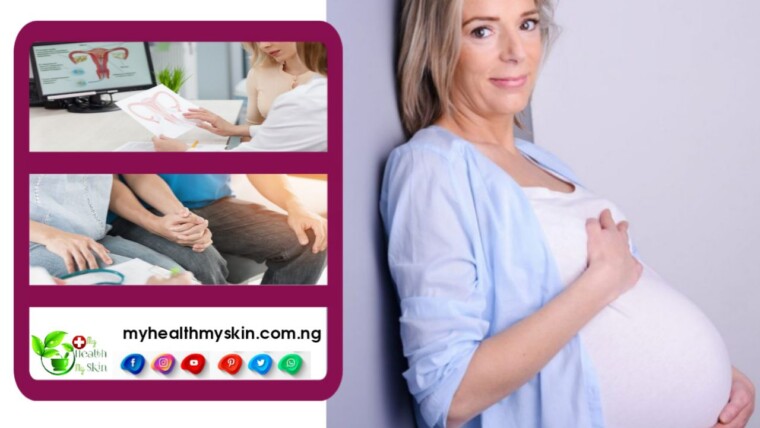As a rule, women know that in each monthly cycle they can get pregnant only on certain days, but at the same time they have a very vague idea of what ovulation is (the release of a mature female germ cell into the fallopian tube and its readiness for conception).
Although knowing about this and understanding how one’s own body is arranged is useful for everyone who cares about their health and is engaged in pregnancy planning. Or, on the contrary, for those who do not want to have children yet.
From birth, every woman has two ovaries (organs in which female sex cells mature), located on either side of the uterus, which create cells for conception and birth.
And ovulation is one of the main processes that shape the reproductive function of the fair sex.
Read Also: How do i know when i’m ovulating?
About ovulation in the simple words
So, what is ovulation and when does it happen? This is one of the stages of the menstrual cycle, during which there is a rupture of the mature membrane with the exit into the abdominal cavity of a female germ cell completely ready for fertilization.
This happens approximately in the middle of the cycle, 14 days after the start of the previous menstruation.
To make it clearer, you need to consider that the monthly cycle of every woman consists of several stages, one of which is ovulation.
At the first stage, menstruation occurs, which can be called “cleansing” of the body.
During it, the maturation of a new germ cell takes place, and then directly ovulation occurs, which passes into the period of preparation of the woman’s body for possible pregnancy.
If this does not happen, then the cycle begins again, that is, a new menstruation begins.
The shell, in which the egg develops, is located in the female gonad – the ovary, and is a watery protective bag that bursts when the woman’s body becomes ready for fertilization.
After the germ cell enters the abdominal cavity, the membrane turns into a “yellow body”, so called because of the dye that accumulates in it.
If fertilization did not occur, and the germ cell left the body along with menstrual discharge, the development of a new membrane begins with a new cell maturing in it.
From birth, every woman has about one million germ cells in her gonads – ovaries, which are in the membranes. But not all of them live to the period of puberty.
After its onset, in each monthly cycle, the maturation of twenty germ cells begins in one follicle, of which only one matures and is released.
Then it will enter the uterine cavity, where it will be able to meet with the male germ cell. The ovulation cycle usually occurs between the 14th and 16th day of the menstrual cycle and lasts about a day, during which the germ cell can be fertilized.
There is also a small chance of conception two days before ovulation.
Many people confuse the concepts of “ovulation” and “fertility” (ability to conceive).
Despite the fact that they are interconnected, these words denote different concepts.
Ovulation is directly the process of releasing a cell ready for fertilization, which begins from the moment a girl reaches puberty.
And fertility is a woman’s ability to conceive, bear and give birth to a healthy child.
The so-called fertile days (days when conception is possible) occur a few days before the egg is released.
At this time, a woman’s body is as ready as possible for sexual contact and conception.
The mucus secreted at this time can store male germ cells – spermatozoa, active for up to 5 days.
Thus, pregnancy can occur even when sex was a few days before ovulation.
Together with the end of ovulation, the days when fertilization is possible end. Men also have the concept of fertility, but in them it is permanent, while for women it is a short and fleeting period.
But even knowing what ovulation is in women, you need to remember that the timing of its onset varies greatly depending on the specifics of a particular menstrual cycle.
In the same woman, the possible time of ovulation may vary in each month.
Therefore, in addition to following the calendar, you need to monitor her characteristic symptoms, some of which women can recognize themselves, and some of which are understandable only to a doctor.
Read Also: When is Ovulation in the Cycle?
Signs of Ovulation
The very process of ovulation occurs without symptoms, and a woman cannot feel it.
In some cases, she may feel a short tingling or pulling pain in the lower abdomen or a feeling of tension in this area.
There are a number of factors by which a woman can understand that her body is ready for conception, although they are considered quite subjective.
These are mood swings and emotional instability in general, as well as an increase in sexual desire, which is observed a few days before the day the germ cell comes out of the shell. But there are also objective symptoms:
- Change in discharge from the vagina. A day before the release of a female reproductive cell – eggs, they change in consistency and color, can become more abundant, stringy and viscous, resembling the white of a raw egg. At the time of ovulation, they become sticky.
- A change in temperature in the anus, vagina or under the tongue, which must be measured every morning after sleep. Its gradual rise indicates the approach of ovulation, and on the day of its onset, it rises by one degree.
- Change in the hormonal background. In the process of maturation of the germ cell, the hormone responsible for the growth of its shell – the follicle – is activated, but this can be determined only by the results of laboratory tests or special pharmacy tests for ovulation.
Medical signs of ovulation are more complex and are determined using various tests.
Yes, the urine test is based on a special hormone that is not always present in it.
Therefore, a significant increase in its concentration clearly indicates that the egg will be released from the shell after 24-36 hours.
Today, urine tests are sold in pharmacies and are available to everyone, but you need to know when they should be performed.
If the menstrual cycle is constant, then testing should be started 17 days before the start of the next menstruation.
If the cycle is unstable, you need to choose the shortest cycle in six months and calculate the time according to it, but the result in this case will not be accurate.
The test is carried out very simply – in the package there are strips of paper divided into two halves.
One of them is control, and the other is diagnostic and has no color until it comes into contact with urine.
To conduct the test, you need to dip the strip into the urine for 3 seconds and look at its color.
If the diagnostic half acquires the same color as the control or darker, then the result is positive and ovulation has occurred.
If the color turns out to be lighter, then you need to continue doing the tests further.
It is possible to determine the maturation time of a female germ cell by opening the cervix (the canal connecting the uterus and vagina).
Despite the fact that many women are usually afraid of this method.
But when hormonal changes and restructuring occur in the body, for example, during breastfeeding or during premenopause, this method is the most suitable and accurate, so it is desirable to master it.
Before ovulation, the cervix is dry and quite hard, lowered into the vagina and closed, but by the time the female germ cell is released from the shell, it becomes wet and begins to be covered with mucus.
Then it opens and rises to take a position convenient for the penetration of male germ cells.
During ovulation, the cervix is soft, and after completion, it becomes hard and dry again. Then it closes and goes down.
Readiness for conception can also be determined by saliva – this method is also called the “fern symptom”.
When a woman ovulates, a certain hormonal balance is maintained in her body, due to which saliva applied to a microscope slide begins to form crystals that resemble fern leaves.
Read Also: First Pregnancy Symptoms: What Signs Should I Watch Out For? Check All Details Here!
What is ovulation day and how to calculate it?
The main reason for accurately calculating the day of ovulation is the desire or unwillingness to get pregnant.
The possibility of pregnancy is greatest precisely during the release of the germ cell. The so-called safe days are coming the next day.
In general, it is not difficult to calculate the day of ovulation, because it occurs in the middle of the menstrual cycle, but there are a number of nuances, such as the natural and age-related features of the female body, as well as the influence of various factors.
The duration of the cycle is different for every woman, the cycle can be unstable, it can be affected by medications, stressful situations and even physical exertion.
So what is ovulation day? This is the day when the possibility of getting pregnant is maximum.
The calculation of this day is based on the length of the menstrual cycle and the data indicated in the women’s calendar – the first and last day of menstruation, the moments when vaginal secretions changed and signs of changes in well-being and mood.
When the duration of the cycle is known and relatively constant, it is enough to divide it by two, and thus we get the day of ovulation, with an error of plus or minus two days.
So, if the menstrual cycle is 28 days, then ovulation will occur on its 14th day.
If the cycle is constantly unstable, then there are the following formulas for calculating ovulation:
- Determine the shortest cycle per year according to the calendar and subtract the number 18 from it;
- Determine the longest cycle and subtract the number 11 from it.
If a temperature graph is kept, then the day of ovulation can be determined using the data obtained as a result of constant measurements.
When the line in the graph rises sharply, that is, there is a jump in temperature, this indicates that the process of ovulation has begun in the female body.
But if the cycle itself is unstable, then such calculations, most likely, will turn out to be incorrect and cannot be relied on.
This knowledge is especially important for girls who plan to get pregnant in the near future.
In the extreme case, if a woman makes great efforts to get pregnant, the day of ovulation can be calculated with the help of a medical examination – ultrasound and special tests, which will show the maturation of the germ cell in the membrane and hormonal changes in the body.
The results of such an examination are the most accurate.
Read Also: How To Have Sex To Get Pregnant
Ovulation cycle
The duration of ovulation refers to the life time of a female germ cell in the fallopian tube, during which it can meet a male germ cell and form an embryo. It usually lasts from 16 to 48 hours, but 24 hours is taken as the average by medical sources.
But, of course, the duration of ovulation is an individual concept for each woman.
In addition, male germ cells – spermatozoa can be very strong and remain in a woman’s body for several days, waiting for a female germ cell – an egg, so a couple of days before and after ovulation can be considered favorable for conception.
In addition, three variants of the period are distinguished, which are characterized by a deviation of the ovulation dates in one direction or another:
- Early ovulation – occurs a few days before the expected date,
- Late ovulation – occurs a few days after the expected date,
- Absence of ovulation – a period when the egg does not leave the shell.
All these cases can be either a variant of the norm, which is not a pathology, or a symptom of gynecological problems.
Hormonal failure, increased nervousness, stress, infectious and chronic diseases, bad habits, diets and an excessively active lifestyle can also lead to this.
Read Also: watery discharge feels like i peed myself
Absence of ovulation
With an irregular menstrual cycle, ovulation may be absent or not occur every month.
However, a regular cycle is also not a guarantee of its appearance.
If long attempts to get pregnant do not lead to anything, a woman should suspect a lack of ovulation, which is associated with a hormonal failure, problems with hormones, an inflammatory process in the genitals, other systemic diseases and constant stress.
Also, violations with the onset of ovulation can be hereditary, or appear as a result of a recent abortion or long-term depression.
But starting to suspect the absence of ovulation, you must take into account that:
-
- if ovulation did not occur in a specific menstrual cycle, this does not mean that it is completely absent,
- the diagnosis of “absence of ovulation” is made only as a result of a comprehensive examination,
- it is necessary to carry out research on the presence of ovulation only in the case of already existing problems with conception, and not at the stage of pregnancy planning.
Absence of ovulation is treated with the help of hormonal drugs, which are stimulators of ovulation and cause a condition in which several eggs mature at once and the chances of conception increase significantly.
These methods are widely used during IVF (artificial insemination) procedures, and you should never resort to them yourself.
Uncontrolled use of hormonal agents can cause serious negative consequences for a woman’s body.
Therefore, it is important to consult a specialist who will select the appropriate drug and draw up a treatment plan.










